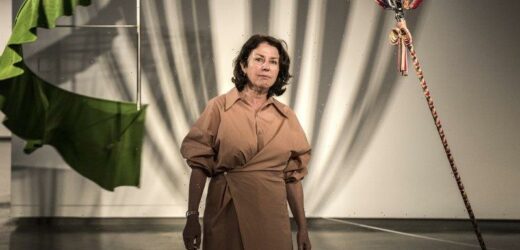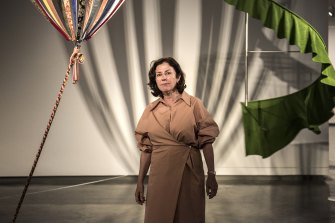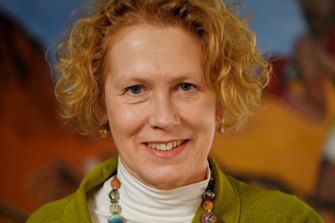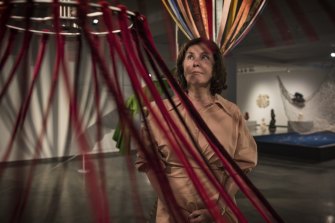The new director of the Museum of Contemporary Art hopes to use her global contacts, cultivated over 30 years leading some of Europe’s prestigious galleries, to bring the best international artists to Sydney.
Leonardo da Vinci’s Mona Lisa might warrant the long flight to Paris, says Suzanne Cotter, but in the realm of contemporary art “people in Sydney deserve to be able to see the best that is out there…here where they live”.
The new MCA director Suzanne Cotter with an installation work by Hannah Garside.Credit:Steven Siewert
Melbourne-born Cotter has also committed to increasing the visibility of Indigenous artists and emerging artists and the Primavera exhibition series for artists aged 35 years and under. She takes over the MCA at a critical juncture in the life of the institution, established 30 years ago through a bequest by Australian expatriate artist John Power.
During those three decades, Cotter has served as curator of the Solomon R. Guggenheim Foundation in New York, director of the Museum of Contemporary Art of the Serralves Foundation in Porto, in Portugal and the Musée d’Art Moderne Grand-Duc Jean (MUDAM) in Luxembourg.
In these prestigious academies, she has showcased the best of contemporary and modern art including major exhibitions of the work of Wolfgang Tillmans, Julie Mehretu, Anish Kapoor, (the late) Joan Miro, and William Kentridge.
Cotter, like her predecessor Liz Ann Macgregor, is not prescriptive about what defines art. She says it is everywhere in our lives, not merely on gallery walls.
The artistic worth of Banksy lies in the presentation of recognisable imagery under the guise of anonymity -“almost like a guerilla presence that inserts itself into the public domain, and bypasses the museum or gallery”. She’s unwilling, too, to dismiss the artistic value of Non-Fungible Tokens, a form of cryptocurrency in which the permanent digital files of works are purchased, and has reserved final judgement.
It was during a visit to the Louvre in the 1980s, as a backpacker in her early 20s, that Cotter had a “light bulb moment” and decided to return to the University of Melbourne to study art history and fine arts.
“I was so overwhelmed – and I wasn’t looking at the Mona Lisa by the way – I just saw this wondrousness of it, and I said to somebody in my very poor French, ‘What do you do to work in a place like this?’”
Her decision to return to helm the MCA was the answer to her “big question” of the last decade: “Where am I going to end?”
“I was following my career path and having these amazing experiences and suddenly, I was like, ‘Is this enough?’. COVID-19 clarified her priorities too, with Cotter losing her mother Elaine last year. She was unable to attend her funeral due to border closures.
One of the starkest changes she has observed on her return to Australia is the recognition given to First Nations. Giving her first acknowledgement of country brought her almost to tears.
Liz Ann Macgregor left the MCA at the end of 2021 after 22 years as director.Credit:Nick Moir
COVID-19 has forced a kind of reckoning for cultural institutions too. Cotter takes over the MCA from Macgregor who she credits as ushering the institution from “young teenager” to adulthood.
“She’s nurtured a fully formed, very accomplished, very successful, and highly recognised arts institution and I would like to build on that work and see the museum recognised more fully as that adult.”
Visitors are returning to the MCA and its galleries are busy but last year’s attendance figures were 40 per cent of what they were pre-pandemic. The museum was closed for 108 days in 2021, and it missed the international tourists making up 40 per cent of its numbers.
That’s problematic for an institution that derives one-quarter of its income from functions, events, and sales from its bookstore and cafe. Cotter will not change free museum entry but “ticketed exhibitions will definitely remain”.
It’s to be seen if financial prudence and government crisis support will save MCA from cumulative losses. Cotter is philosophical about the impact of COVID-19, and predicts the disruptions are “going to continue for quite some time”.
Nevertheless, she recognises that the MCA may need to rethink its financial models “to give us greater security in the future”.
Art is everywhere says Cotter.Credit:Steven Siewert
“I think the last thing we are doing is imagining a magical day where this world we’re living in now is somehow different, with climate change too. “I don’t think there’s any doubt in anyone’s mind that the world is shifting irrevocably. To quote Doug Aitken, it’s a new era.
“Everyone working here believes in the idea that art and culture are actually good for you. They can contribute to a sense of well-being that takes you out of the day-to-day. We want to really assert the importance of culture at this time through our activities and if that means sometimes our doors are closed and we have to revert to doing something outdoors and on digital platforms, then that’s what we’ll do, and that’s pretty much what every museum in the world has been doing for the past two years.”
In November, the Art Gallery of NSW’s new contemporary art museum Sydney Modern opens. Cotter dismisses suggestions that Sydney is not big enough for two players.
“I don’t think it’s particularly helpful to see it as competition. I think it further strengthens the critical significance of Sydney as an artistic capital. If you go to London, it’s not just Tate Modern, actually, you have the Serpentine, you have the Royal Academy, you have Whitechapel, they are all of different scales but they all play a role.
“If anything, I think it also liberates us and gives us more freedom to be more responsive in certain aspects of our programming than it might be possible for somebody like Sydney Modern. We’ll be, if you like, a smaller ship to turn around.”
A cultural guide to going out and loving your city. Sign up to our Culture Fix newsletter here.
Most Viewed in Culture
From our partners
Source: Read Full Article





